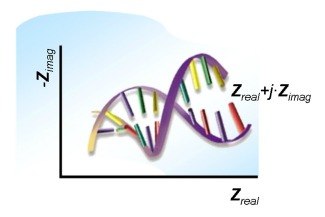Genosensors, sensors made with DNA

The increasing interest for biosensors and especially genosensors during recent years is motivated by the needs of realizing very rapid analysis with simple equipment, and involving lower costs compared to the more classical techniques.
The determination of genes is a current demand in fields like food and water contamination, detection of pathogens and diagnostic of genetic diseases, tests on food fraud or breeding origin, plus applications to forensic issues.
DNA biosensor technologies are rapidly developing as an alternative to the classical gene assays, due to their potential miniaturization, portability and in situ analysis. Among available detection techniques, Electrochemical Impedance Spectroscopy is rapidly developing as a tool for studying biosensing events at the surface of an electrode, such as DNA hybridization. In addition, this technique presents also the advantage to allow the analysis of unlabelled DNA sequences.
In the past few years the use of nanoscale materials for electrochemical biosensing has seen explosive growth. The huge interest in nanomaterials is due to the ability to tailor their size and structure and to the exceptional properties they present compared to the bulk material. The use of nanomaterials in impedimetric genosensing is focused either on the development of new platform or on the conjugation of DNA sequences with the former in order to enhance the impedimetric signal, thus improving the sensitivity of the system.
The commented review article, derived from the completion of the Doctoral Theses by A.Bonanni, summarizes the state of the art of DNA sensors (or genosensors) that utilize electrochemical impedance spectroscopy as the transduction technique. As issue of current interest, it is centered on the use of nanomaterials to develop or to improve performance of these specific biosensors.
It describes the different principles that may be employed in the measuring step and the different formats adopted for detection of a DNA sequence or confirmation or amplification of the finally obtained signal. The use of nanomaterials for the above listed aspects, viz. the use of carbon nanotubes or other nanoscopic elements in the construction of the electrodes, or the use of nanoparticles, mainly gold or quantum dots, for signal enhancement is fully revised and shown with work in our laboratories.
References
"Use of nanomaterials for impedimetric DNA sensors: a review", A.Bonanni, M. del Valle, Analytica Chimica Acta, 2010, Vol: 678: 7-17.


